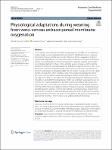Item Infomation
Full metadata record
| DC Field | Value | Language |
|---|---|---|
| dc.contributor.author | Patrick Duncan, Collins | - |
| dc.contributor.author | Lorenzo, Giosa | - |
| dc.contributor.author | Valentina, Camarda | - |
| dc.date.accessioned | 2023-03-23T01:39:46Z | - |
| dc.date.available | 2023-03-23T01:39:46Z | - |
| dc.date.issued | 2023 | - |
| dc.identifier.uri | https://link.springer.com/article/10.1186/s40635-023-00493-8 | - |
| dc.identifier.uri | https://dlib.phenikaa-uni.edu.vn/handle/PNK/7075 | - |
| dc.description | CC BY | vi |
| dc.description.abstract | Veno-venous extracorporeal membrane oxygenation (V–V ECMO) has an established evidence base in acute respiratory distress syndrome (ARDS) and has seen exponential growth in its use over the past decades. However, there is a paucity of evidence regarding the approach to weaning, with variation of practice and outcomes between centres. Preconditions for weaning, management of patients’ sedation and mechanical ventilation during this phase, criteria defining success or failure, and the optimal duration of a trial prior to decannulation are all debated subjects. Moreover, there is no prospective evidence demonstrating the superiority of weaning the sweep gas flow (SGF), the extracorporeal blood flow (ECBF) or the fraction of oxygen of the SGF (FdO2), thereby a broad inter-centre variability exists in this regard. | vi |
| dc.language.iso | en | vi |
| dc.publisher | Springer | vi |
| dc.subject | Veno-venous extracorporeal membrane oxygenation | vi |
| dc.subject | acute respiratory distress syndrome | vi |
| dc.title | Physiological adaptations during weaning from veno-venous extracorporeal membrane oxygenation | vi |
| dc.type | Book | vi |
| Appears in Collections | ||
| OER- Y học- Điều dưỡng | ||
Files in This Item:

